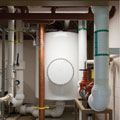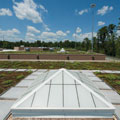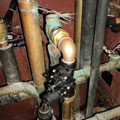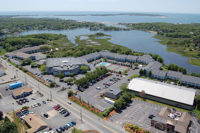No more jailhouse blues. Federal Bureau of Prisons architect Jon Gomberg figures the average inmate in a correctional facility goes through 200 gallons of water a day.

Federal Bureau of Prisons architect Jon Gomberg figures the average inmate in a correctional facility goes through 200 gallons of water a day.
“Eight-five percent of that goes to the wastewater treatment plant,” says Gomberg, who is FBOP’s chief of the technical support section for the design and construction branch.
That’s a bit too high on the water consumption chart for FBOP’s tastes. “Our overall goal is to reduce the cost of operation and ownership and at the same time look toward sustainable facilities by being good stewards,” he says.
FBOP and correctional facilities around the country are making major inroads when it comes to the use of sustainable products and technologies within their walls aimed to reduce water consumption and energy costs, while maintaining high levels of functionality and security.
Three new FBOP facilities in Mississippi, West Virginia and Alabama are at varying stages of completion and feature many sustainable features. Of the three facilities, two are designed at LEED Silver certification and the other is LEED-certified.
“With all the new buildings we’re reducing water consumption by at least 30% with low-flow fixtures throughout the facilities and through the use of recycled laundry water,” Gomberg says. “We’re really trying to minimize water consumption.”
FBOP’s laundry water recycle system takes water from the final wash cycle and runs it through a five- or six-component filtration process. Once filtered, the water is reused for further laundry services.
“Laundry is the biggest year-round load in a prison,” FBOP Senior Mechanical Engineer Snehal Desai, P.E., LEED AP/BD+C, says. “By using a recycle system, water usage is reduced 20% to 40%. You also are conserving energy because you are not using that much hot water.”

Flushing away problems
While water usage through laundry, kitchen and bathroom activities is expected, a correctional setting presents a different kind of challenge for facility personnel in attempting to curtail inmate water use for nefarious purposes.
“If inmates know they are going to be extracted from their cells, they will flood them so the floor is slippery and staff cannot get in there to remove them,” explains Shawn Bush, president and CEO of Florida-based plumbing controls manufacturer I-CON Systems. “They use the toilet to flush contraband and they use it as a trash can. They will flush banana peels down so they don’t have trash in their cells.”
Bush’s company has engineered a number of point-of-use solutions aimed at curtailing water abuse in correctional facilities. His company’s client list is almost exclusively comprised of correctional facilities around the country.
“You take a 1,000-bed facility and it’s the same amount of water being used by a small city,” he says. “We control the plumbing fixtures inside the correctional facility.”
In addition to creating its own flush valve that will flush 1.0 gallons on a standard 1.6-gallon toilet, I-CON’s electric plumbing controls systems allow correctional facilities to control the amount of times an inmate flushes his or her toilet.
“Inmates will use the toilet to flush bed sheets, clothing and contraband,” Bush says. “We have a system where if an inmate flushes twice within five minutes, the control panel locks the toilet for an hour.”
The system ties into a control panel and computer where the correctional officers are located. The officers can electronically control each individual cell’s toilet use or an entire pod’s toilet use.
“If a guard is going to search a pod, once he walks into that pod area all the toilets are flushing contraband,” Bush says. “With our system, the officer can hit a button on a touch screen and shut down the toilets in the entire pod.”
And if an inmate continues to frantically press the flush button hoping the toilet will start flushing before the officer arrives, that movement is recorded as well.
“They can search the monitoring system and see who is pushing the button like crazy and then they know to go search that particular cell,” Bush says.
I-CON’s products and systems are installed in 400 correctional facilities across the country at the local, state and federal levels. I-CON’s lav valves and flush valves not only reduce water consumption, but contain fewer parts, thus reducing maintenance costs. “We’re cutting water bills in half and increasing prison security,” Bush says.
I-CON installs a meter to monitor before-and-after water usage at a facility. “We monitor for 30 days and compare the manual system to our system, and we typically see 65% to 80% savings in water,” Bush states.
I-CON also has a system designed to trap contraband before it reaches a point where it could clog the plumbing system. Bush points out it takes 60 flushes (his company has done studies) to flush an entire bed sheet down the toilet.
“That sheet goes down the line until it gets to the first bend and jumbles up and blocks the entire system,” he says. “Multiple floors of the facility could flood because of that one sheet. A plumber would have to go in and cut a section of pipe out to get to it. It’s a big nightmare.”
The capture system sits behind the sewer line and is equipped with probe- and hook-like mechanisms. The hooks grab the contraband and trigger a controller that prevents further flushing.
FBOP uses an I-CON system in some of its facilities to limit shower water use. “It limits abuse,” Desai says. “It locks down and puts a time limit on how long someone can take a shower. After five minutes, it won’t turn on again.”

Taking green to the next level
In addition to reducing water usage, correctional facilities are embracing additional green technologies to lower overall energy consumption. FBOP has installed or is investigating technologies such as geothermal, rainwater harvesting, nonpotable water reuse for flushing purposes and the use of solar thermal for domestic hot water.
The new Naval Consolidated Brig in Chesapeake, Va., combines former prison populations from the Marine brigs at Quantico and Camp Lejeune, along with the naval brig in Norfolk, Va. The Naval Consolidated Brig, designed to hold 400 inmates, houses all branches (male and female capabilities under the same roof) of the service, including the Coast Guard. The Department of Defense Level II facility houses prisoners pretrial and posttrial up to five-year sentences.
The first new naval brig in two decades had the directive to certify at LEED Silver in compliance with Naval Facilities Engineering Command.
It features a geothermal climate control system, energy recovery wheels, a graywater recycling plant, and ground water collection ponds and runoff water reclamation swales. Each of the prisoner dorms has a vegetative roof.
The geothermal system, while more expensive to install, will yield cost savings for the lifetime of the facility, Naval Consolidated Brig Technical Director Jim Adams says. Some 324 bore wells are located below the prisoner recreation yard and feed back to a central plant, which provides the facility’s heating and cooling. The system features two Bell & Gossett pumps that alternate lead operations every 250 hours at midnight.
A 10,000-gallon Highland Tank graywater recycling system recovers water from showers, sinks and water fountains and reroutes it to the plant for filtration, dying and redistribution to prisoner toilets. Adams says thousands of gallons of water will be saved each year as a result of the graywater system. Kohler toilets and urinals are installed in staff areas, while Acorn toilets and showerheads are used in inmate areas.
Two ground water ponds manage the water from the secure portions of the facility (recreation yards and inner courtyards). Two swales handle water runoff from the nonsecure areas at the front of the building. Both the ponds and swales are seeded with various aquatic vegetation and plants. The plants and the construction of the ponds and swales all work together to filter impurities from the water before it seeps back into the ground water. The vegetative roof serves to absorb water runoff by storing and absorbing rainwater.
FBOP is investigating the future use of an ozone cold water wash for laundry. “You would save hot water,” Gomberg says. “You inject ozone into the wash and that provides the disinfection. You have to get everybody on board with something like that. We know that water has to get to 160° F to get it to sterilization. You’d have to have that sterilization documentation with the cold water wash. We don’t want to spread any disease.”
Gomberg notes FBOP would like to do even more on the conservation side, but must be mindful of expense.
“Renewables elude us right now,” he says. “Everything from a conservation standpoint, we’re doing. We have all the low-hanging fruit out there. We would give anything for something such as a wind turbine, but those paybacks are horrific.”
Desai adds: “Before we head off any technology, we look at paybacks. We look for things that can pay back in less than 10 years. Anything we do we look at life-cycle cost and payback.”


